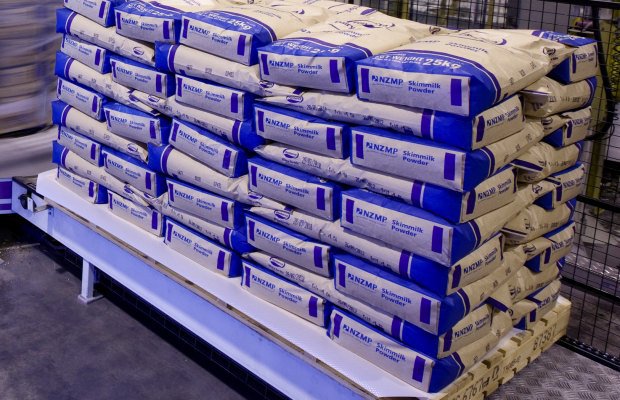Milk price futures had a big week, with large increases on both the second and third contracts.
The 2022-23 contract settled at a record $10.63/kg MS, up 3.2% from the previous week. This contract’s open interest has also now exceeded the OI of the nearest contract, massive considering that the second contract is still 17-months from expiry. In fact, this is the first time the second MKPF contract has done this, indicating the maturity of the market within the NZ milk market alone. The 2023-24 contract has also had a big week, up 3.8% to a massive $9.45/kg MS despite being 27 months out.
The NZX Milk price forecast for the current season has jumped in response to milk price futures trading, at the time of writing, now sitting at $10.38/kg MS with a range of $10.10-$11/kg MS.
Fonterra has been quick to move upwards, with a readjustment of their farm gate milk price forecast after less than a month. Their forecast has moved from a midpoint of $9/kg MS, 50c/kgMS higher to a midpoint of $9.50/kg MS. It is expected that other NZ processors will start releasing their own milk price forecast updates soon enough. One aspect that will keep this season’s milk price game exciting is the current price differential between skim milk powder, milk fats and whole milk powder. In the last 10 years we haven’t seen prolonged timeframes of this outcome, which is currently playing into the hands of certain processors, and less of others; the NZ milk market heats up in another dynamic.
What happened last week in dairy?
Aussie milk price pushes higher
The Australian milk market continues to flux higher. At the time of writing, most processors had adjusted their milk price forecast for the 2022-23 season, higher four times. Fonterra Australia has pushed their price to $9.10/kg MS, following last season’s price of $7.40/kg MS. Saputo has priced butterfat at $5.80/kg and protein at $11.60/kg for the August to December period, with a 14% price increase for both constituents supplied in July, and the period from January to June. Lactalis Australia, in the same region as Saputo above, is pricing butterfat at $6.40/kg, and protein at $9.61/kg in the peak milk months.
Long story short, processors continue to jostle around price; the average price increase from the season prior is set to be significant across the board. This price differential stems from the range of domestic prices and global market and the shifting price scale of both. Reports point to the Australian domestic market being very short of butter – how this plays out within the Aussie milk market going forward will be interesting to keep an eye on.
Milk protein values keep pushing higher
The aggregate export value of casein and caseinate exports continues to grow, up 41.5% year-on-year (YoY) in May, even though export volumes reduced compared to the same month a year prior. The NZX collected price of Oceania-produced casein continues to climb too, now eclipsing $15,000/t for the aggregate price of casein products. The US and China continue to be the key export countries for casein exports.
Likewise, whey export values continue to increase also, with May’s average export value 22.75% higher than the same time last year, eclipsing US$7000/t for the first time. Whey exports were lighter YOY in May, in line with other exports. The US continues to be a key market for NZ whey exports as well. The values of milk proteins continue to drive stream return decisions in NZ; demand remains and there is little doubt that caseins, WPCs and others, are the best valorisation for NZ milk currently.
European milk supply continues to struggle
European milk supplies continue to constrain with processors attempts to incentivise with higher milk prices being turned away.
The European milk price as reported by Friesland Campina, sits 60% higher YoY, with a guaranteed price of €6.00/kg MS compared to €3.75/kg MS in July 2021.
Despite the incentive, increased farm input costs and pressure from local government to reduce emissions has seen numbers steadily decrease over the season. Europe has reported another production decline for the month of April, with the EU and UK reporting a 0.9% decline YoY and 0.4% year to date (YTD) with a total of 14,020 million mt produced.
Germany, France, UK, and the Netherlands have reported April milk production declines of 2.6%, 2.0%, 1.7%, and 2.6% YoY respectively, a continuation of the trend we have seen out of these nations this season. YTD, these countries have reported declines of 1.7%, 1.3%, 1.9% and 2.2% respectively.
Italy and Poland continue to report milk production increases, with an increase of 8.1% and 1.1% respectively YoY, and 4.3% and 2.5% respectively YTD. While these nations have had strong seasons, heat waves through Italy are looking to impact June production with rivers and lakes evaporating around the country.
As ports and logistics around Europe are constrained due to the impact of the conflict in Ukraine, it is no surprise that exports have declined. Total dairy exports out of Europe declined 17% in April YoY and 11% YTD. Despite the drop, as demand has pushed dairy commodity prices over the last few months, Europe’s total dairy export values in April have increased 1.4%.
Of their exports, all major dairy commodities have decreased YoY in April, with WMP, SMP, AMF, butter, and cheese down 29%, 21%, 20%, 16% and 11% YoY respectively. Notable decreases include exports into China and Africa across all commodities as the lockdown in China and conflict in Ukraine continue to impact shipping and commodity trade. On the other hand, South East Asia and North America had notable increases in purchase volumes of European butter and whey.










